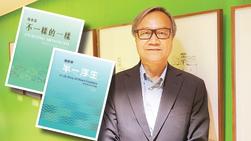 Two new books by Sun Museum director Yeung Chun-tong consider how ancient Chinese wisdom might help people cope with present-day problems, including a global health crisis. (PHOTO PROVIDED TO CHINA DAILY)
Two new books by Sun Museum director Yeung Chun-tong consider how ancient Chinese wisdom might help people cope with present-day problems, including a global health crisis. (PHOTO PROVIDED TO CHINA DAILY)
Two books by Yeung Chun-tong, director, Sun Museum, were published recently. Both Evolving Monolith and A Life Story of Mixed Emotions explore what connects us to the past and the role of traditional Chinese culture and arts in helping people cope with present-day problems, the ongoing global health crisis for example.
Evolving Monolith investigates the idea of Chinese culture being a monolithic one, citing evidence that it has, in fact, never stopped changing and evolving over thousands of years. In 32 short but interesting pieces (illustrated by cartoons Yeung drew himself), the author describes how often the same object could signify different ideas, in keeping with the changes in social and cultural situations. For example, the colors red and yellow have suggested different ideas at different periods in time, depending on the cultural context. For example, a flaming red color is expected to inspire danger and fear, but in a religious context red suggests auspiciousness. Also in traditional Chinese culture, flowers had different auspicious connotations: lotus was associated with purity, orchid with nobility, and peony with affluence and honor.
Yeung has worked in museums for more than four decades. After retiring as the director of the University Museum and Art Gallery, in the University of Hong Kong, he joined the Sun Museum in 2013 to continue his efforts in building bridges between art and the general public. As a museum professional, he has curated around 300 exhibitions and delivered more than 200 lectures on traditional Chinese art. He strongly believes in reaching out to the public through devising educational events to promote the cause of Chinese history and culture.
“Chinese people always wish to make life better and happier,” says Yeung. “They embrace change, wishing that the future is going to be better.” Besides citing historical facts, Yeung also focuses on the interior lives of individuals, which makes his writing more accessible to those who may not be that familiar with Chinese art history.
Surviving hard times
A Life Story of Mixed Emotions is narrated by a fictional character named Ping Buen-yat. Set in the 1950s and 1960s, these are portraits of Hong Kong from when it used to be a poverty-stricken place and people’s lives were full of drudgery. The 22 short stories about Ping and his family reflect the hardships endured by the grassroots people in Hong Kong half a century ago. The book depicts their anxiety and struggles, and the continuous pursuit of happiness through a difficult time.
While the stories can be rather stark, the illustrations add a light touch. According to Yeung, the idea is to mirror the bittersweetness of life. He has tried to blend philosophical thoughts from ancient China with modern life in his sketches, besides conveying a feeling of compassion, at a time when much of the world is trying to come to grips with the COVID-19 pandemic.
The book launch and an exhibition of Yeung’s drawings had to be cancelled because of the surge of coronavirus cases in the city. Yeung, however, is trying to look on the brighter side of things. Through his stories and drawings, he is encouraging readers to retrace the history and learn from ancient wisdom.
“The Chinese history is a history of struggles and challenges, but we Chinese people always know how to tide over the crisis,” says Yeung who believes the power of art can bring us comfort in the time of a pandemic and lead us toward unexpected wonders and possibilities.
If yoy read
Evolving Monolith
A Life Story of Mixed Emotions
By Yeung Chun-tong
Published by Sun Museum, Hong Kong
www.en.sunmuseum.org.hk/publications


